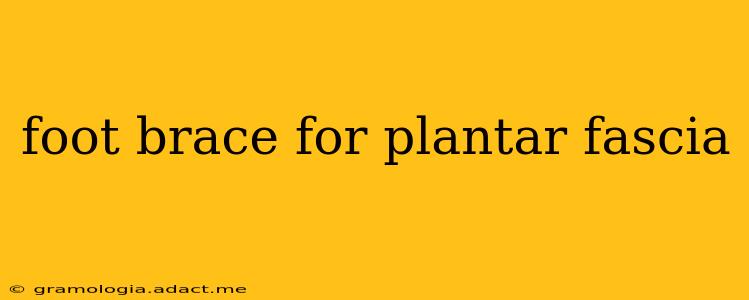Plantar fasciitis, that sharp pain in your heel and arch, can make even simple activities feel impossible. Finding the right foot brace can be a game-changer in managing this common condition. But with so many options available, choosing the best plantar fasciitis foot brace can feel overwhelming. This comprehensive guide will help you navigate the world of foot braces and find the perfect fit for your needs.
What is Plantar Fasciitis?
Before diving into the world of foot braces, let's briefly understand plantar fasciitis. This condition involves inflammation of the plantar fascia, a thick band of tissue on the bottom of your foot that connects your heel bone to your toes. Overuse, improper footwear, tight calf muscles, and even obesity can contribute to plantar fasciitis. The resulting pain is often most intense in the morning or after periods of rest.
What are the Different Types of Plantar Fasciitis Foot Braces?
Several types of foot braces offer support and relief for plantar fasciitis. Choosing the right one depends on the severity of your condition and your personal preferences.
Night Splints:
These braces are worn at night to gently stretch the plantar fascia and reduce morning stiffness. They typically hold your foot in a dorsiflexed position (toes pointed upwards).
Arch Supports (Insoles):
These are placed inside your shoes and provide cushioning and support to the arch of your foot, helping to distribute pressure and reduce strain on the plantar fascia. They come in various materials and levels of support.
Sleeves and Wraps:
These offer compression and support to the entire foot and ankle, providing warmth and mild compression to reduce inflammation.
Heel Cups:
These focus on providing support and cushioning specifically to the heel, reducing pressure on the plantar fascia. They often incorporate a gel or foam padding for added comfort.
How Do I Choose the Right Plantar Fasciitis Foot Brace?
Selecting the appropriate brace depends on various factors:
- Severity of Pain: For mild pain, arch supports or sleeves might suffice. More severe pain might require night splints or more supportive braces.
- Activity Level: If you're highly active, you'll need a brace that offers excellent support and durability.
- Shoe Type: The type of shoes you wear will influence the type of brace you choose. Arch supports are designed to fit inside shoes.
- Personal Preference: Comfort is key. Experiment with different materials and designs to find what feels best for you.
What Materials are Plantar Fasciitis Foot Braces Made From?
Plantar fasciitis foot braces are often constructed from a variety of materials, each offering unique benefits:
- Gel: Provides excellent cushioning and shock absorption.
- EVA (Ethylene-vinyl acetate): A lightweight, durable, and shock-absorbing material.
- Silicone: Offers good cushioning and flexibility.
- Neoprene: Provides compression and warmth.
How Effective are Plantar Fasciitis Foot Braces?
Foot braces can be highly effective in managing plantar fasciitis pain. They help to:
- Support the arch: Reduces strain on the plantar fascia.
- Reduce inflammation: Compression and support can help to reduce swelling.
- Improve alignment: Proper alignment reduces stress on the foot.
- Increase comfort: Cushioning and support make walking and standing more comfortable.
However, it's crucial to remember that foot braces are not a cure for plantar fasciitis. They are a supportive tool used alongside other treatments like stretching exercises, physical therapy, and rest.
Are There Any Side Effects of Using a Plantar Fasciitis Foot Brace?
While generally safe, some individuals might experience minor side effects such as:
- Discomfort: Initially, some braces might feel slightly uncomfortable until you adjust.
- Skin irritation: Certain materials might cause irritation for individuals with sensitive skin.
- Blisters: Improper fit can lead to blisters.
It's essential to choose a well-fitting brace made from breathable materials to minimize the risk of side effects.
When Should I See a Doctor for Plantar Fasciitis?
If your plantar fasciitis pain is severe, persistent, or doesn't improve with home treatment and over-the-counter pain relievers, it's essential to consult a doctor or podiatrist. They can diagnose the condition accurately and recommend appropriate treatment options.
This information is for general knowledge and does not constitute medical advice. Always consult with a healthcare professional before starting any new treatment plan.
